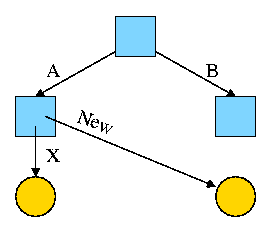
Start Lecture #11
Recall that the primary function of a directory is to map the file name (in ASCII, Unicode, or some other text-based encoding) to whatever is needed to retrieve the data of the file itself.
There are several ways to do this depending on how files are stored.
Another important function is to enable the retrieval of the various attributes (e.g., length, owner, size, permissions, etc.) associated with a given file.
Homework: 25
It is convenient to view the directory as an array of entries, one per file. This view tacitly assumes that all entries are the same size and, in early operating systems, they were. Most of the contents of a directory are inherently of a fixed size. The primary exception is the file name.
Early systems placed a severe limit on the maximum length of a file name and allocated this much space for all names. DOS used an 8+3 naming scheme (8 characters before the dot and 3 after). Unix version 7 limited names to 14 characters.
Later systems raised the limit considerably (255, 1023, etc) and thus allocating the maximum amount for each entry was inefficient and other schemes were used. Since we are storing variable size quantities, a number of the consideration that we saw for non-paged memory management arise here as well.
The simple scheme is to search the list of directory entries linearly, when looking for an entry with a specific file name. This scheme becomes inefficient for very large directories containing hundreds or thousands of files. In this situation a more sophisticated technique (such as hashing or B-trees) is used.
We often think of the files and directories in a file system as forming a tree (or forest). However in most modern systems this is not necessarily the case, the same file can appear in two different directories (not two copies of the file, but the same file). It can also appear multiple times in the same directory, having different names each time.
I like to say that the same file has two different names. One can also think of the file as being shared by the two directories (but those words don't work so well for a file with two names in the same directory).
Sharedfiles is Tanenbaum's terminology.
With unix hard links there are multiple names for the same file and each name has equal status. The directory entries for both names point to the same inode.
real nameand the other one is
just a link.
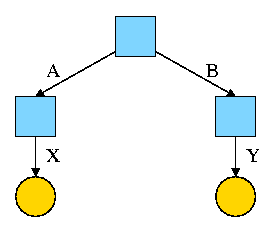
For example, the diagram on the right illustrates the result that occurs when, starting with an empty file system (i.e., just the root directory) one executes
cd /
mkdir /A; mkdir /B
touch /A/X; touch /B/Y
The diagrams in this section use the following conventions
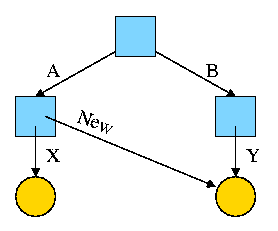
Now we execute
ln /B/Y /A/New
which leads to the next diagram on the right.
At this point there are two equally valid name for the right hand yellow file, /B/Y and /A/New. The fact that /B/Y was created first is NOT detectable.
the file nameS(plural) vs
the file(singular).

Assume Bob created /B and /B/Y and Alice created /A, /A/X, and /A/New. Later Bob tires of /B/Y and removes it by executing
rm /B/Y
The file /A/New is still fine (see third diagram on the right). But it is owned by Bob, who can't find it! If the system enforces quotas Bob will likely be charged (as the owner), but he can neither find nor delete the file (since Bob cannot unlink, i.e. remove, files from /A).
If, prior to removing /B/Y, Bob had examined its link count
(an attribute of the file),
he would have noticed that there is another (hard) link to the file,
but would not have been able to determine in which directory (/A in
this case) the hard link was located or what is the name of the file
in that directory (New in this case).
Since hard links are only permitted to files (not directories) the resulting file system is a dag (directed acyclic graph). That is, there are no directed cycles. We will now proceed to give away this useful property by studying symlinks, which can point to directories.
As just noted, hard links do NOT create a new file, just another name for an existing file. Once the hard link is created the two names have equal status.
Symlinks, on the other hand DO create another file, a non-regular file, that itself serves as another name for the original file. Specifically

Again start with an empty file system and this time execute the following code sequence (the only difference from the above is the addition of a -s).
cd /
mkdir /A; mkdir /B
touch /A/X; touch /B/Y
ln -s /B/Y /A/New
We now have an additional file /A/New, which is a symlink to /B/Y.
/B/Y
The bottom line is that, with a hard link, a new name is created for the file. This new name has equal status with the original name. This can cause some surprises (e.g., you create a link but I own the file). With a symbolic link a new file is created (owned by the creator naturally) that contains the name of the original file. We often say the new file points to the original file.
Question: Consider the hard link setup above.
If Bob removes /B/Y and then creates another /B/Y, what happens to
/A/New?
Answer: Nothing.
/A/New is still a file with the same contents as the
original /B/Y.
Question: What about with a symlink?
Answer: /A/New becomes invalid and then valid again, this time pointing
to the new /B/Y.
(It can't point to the old /B/Y as that is completely gone.)
Note:
Shortcuts in windows 95/98/ME contain more that symlinks in unix.
In addition
to the file name of the original file, they can contain arguments to
pass to the file if it is executable.
So a shortcut to
firefox.exe
can specify
firefox.exe //cs.nyu.edu/~gottlieb/courses/os/class-notes.html
Moreover, as was pointed out by students in my 2006-07 fall class,
the shortcuts are not a feature of the windows FAT filesystem itself,
but simply the actions of the command interpreter when encountering
a file named *.lnk
End of Note.
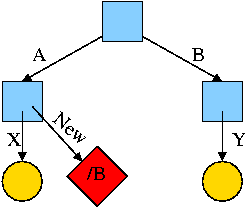
What happens if the target of the symlink is an existing directory? For example, consider the code below, which gives rise to the diagram on the right.
cd /
mkdir /A; mkdir /B
touch /A/X; touch /B/Y
ln -s /B /A/New
This research project of the early 1990s was inspired by the key observation that systems are becoming limited in speed by small writes. The factors contributing to this phenomenon were (and still are).
preparationbefore any data is transferred, and then can transfer a block in less than 1ms. Thus, a one block
transferspends most of its time
getting readyto transfer.
The goal of the log-structured file system project was to design a file system in which all writes are large and sequential (most of the preparation is eliminated when writes are sequential). These writes can be thought of as being appended to a log, which gave the project its name.
cleanerprocess runs in the background and examines segments starting from the beginning. It removes overwritten blocks and then adds the remaining blocks to the segment buffer. (This is very much not trivial.)
Despite the advantages given, log-structured file systems have not caught on. They are incompatible with existing file systems and the cleaner has proved to be difficult.
Many seemingly simple I/O operations are actually composed of sub-actions. For example, deleting a file on an i-node based system (really this means deleting the last link to the i-node) requires removing the entry from the directory, placing the i-node on the free list, and placing the file blocks on the free list.
What happens if the system crashes during a delete and some, but not all three, occur?
A journaling file system prevents the problems by using an idea from database theory, namely transaction logs. To ensure that the multiple sub-actions are all performed the larger I/O operation (delete in the example) is broken into 3 steps.
After a crash, the log (called a journal) is examined and if there are pending sub-actions, they are done before the system is made available to users.
Since sub-actions may be done more than once, it is required that they all be idempotent (applying the action twice is the same as applying it once).
Some history.
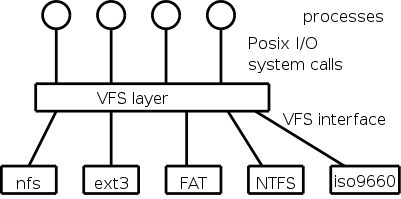
A single operating system needs to support a variety of file systems. The software support for each file system would have to handle the various I/O system calls defined.
Not surprisingly the various file systems often have a great deal in common and large parts of the implementations would be essentially the same. Thus for software engineering reasons one would like to abstract out the common part.
This was done by Sun Microsystems when they introduced NFS the Network File System for Unix and by now unix-like operating systems have adopted this idea. The common code is called the VFS layer and is illustrated on the right.
Since I/O operations can dominate the time required for complete user processes, considerable effort has been expended to improve the performance of these operations.
All general purpose file systems use a (non-demand) paging algorithm for file storage (read-only systems, which often use contiguous allocation, are the major exception). Files are broken into fixed size pieces, called blocks that can be scattered over the disk. Note that although this is paging, it is not called paging.
Actually, it is more complicated since various optimizations are performed to try to have consecutive blocks of a single file stored consecutively on the disk. This is discussed below.
Note that all the blocks of the file are stored on the disk, i.e., it is not demand paging.
One can imagine systems that do utilize demand-paging-like algorithms for disk block storage. In such a system only some of the file blocks would be stored on disk with the rest on tertiary storage (some kind of tape). Perhaps NASA does this with their huge datasets.
There are two conflicting goals, performance and efficiency.
setup timerequired before any bytes are transferred. This favors a large block size.
For some systems, the vast majority of the space used is consumed by the very largest files. For example, it would be easy to have a few hundred gigabytes of video. In that case the space efficiency of small files is largely irrelevant since most of the disk space is used by very large files.
Typical block sizes today are 4-8KB.
There are basically two possibilities, a bit map and a linked list.
A region of kernel memory is dedicated to keeping track of the free blocks. One bit is assigned to each block of the file system. The bit is 1 if the block is free.
If the block size is 8KB the bitmap uses 1 bit for every 64 kilobits of disk space. Thus a 64GB disk would require 1MB of RAM to hold its bitmap.
One can break the bitmap into (fixed size) pieces and apply demand paging. This saves RAM at the cost of increased I/O.

One can link the free blocks together and just keep a pointer to the head of the list. This is very poor since it would require an extra I/O for every acquisition or return of a free block.
In the scheme above a free disk block contains just one pointer; whereas it could hold around a thousand of them. The improved scheme, shown on the right, has only a small number of the blocks on the list. Those blocks point not only to the next block on the list, but also to many other free blocks that are not directly on the list.
As a result only one in about 1000 requests for a free block require an extra I/O.
A bad case still remains. Assume the head block on the list is exhausted, i.e. points only to the next block on the list. A request for a free block will receive this block, and the next one on the list is brought it. It is full of pointers to free blocks not on the list (so far so good).
If a free block is now returned we repeat the process and get back to the in-memory block being exhausted. This can repeat forever, with one extra I/O per request.
Tanenbaum shows an improvement where you try to keep the one in-memory free block half full of pointers.
Two limits are on disk blocks owned by a given user, the so
called soft
and hard
limits.
A user is never permitted to exceed the hard limit, but is permitted
to exceed the soft limit during a login session provided it is
corrected prior to logout.
Often files on directories such as /tmp are not counted since the system is permitted to deleted these files when needed.
A physical dump simply copies every block in order onto tape (or other backup media). It is simple and useful for disaster protection, but not useful for retrieving individual files.
We will study logical dumps, i.e., dumps that are file and directory based not simply block based.
Tanenbaum describes the (four phase) unix dump algorithm.
All modern systems support full and incremental dumps.
An interesting problem is that tape densities are increasing slower than disk densities so an ever larger number of tapes are needed to dump a full disk. This has lead to disk-to-disk dumps; another possibility is to utilize raid.